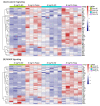Folic Acid Supplementation Promotes Hypomethylation in Both the Inflamed Colonic Mucosa and Colitis-Associated Dysplasia
- PMID: 37296911
- PMCID: PMC10252136
- DOI: 10.3390/cancers15112949
Folic Acid Supplementation Promotes Hypomethylation in Both the Inflamed Colonic Mucosa and Colitis-Associated Dysplasia
Abstract
Purpose: The purpose of this study was to assess the effect of folic acid (FA) supplementation on colitis-associated colorectal cancer (CRC) using the azoxymethane/dextran sulfate sodium (AOM/DSS) model.
Methods: Mice were fed a chow containing 2 mg/kg FA at baseline and randomized after the first DSS treatment to receive 0, 2, or 8 mg/kg FA chow for 16 weeks. Colon tissue was collected for histopathological evaluation, genome-wide methylation analyses (Digital Restriction Enzyme Assay of Methylation), and gene expression profiling (RNA-Seq).
Results: A dose-dependent increase in the multiplicity of colonic dysplasias was observed, with the multiplicity of total and polypoid dysplasias higher (64% and 225%, respectively) in the 8 mg FA vs. the 0 mg FA group (p < 0.001). Polypoid dysplasias were hypomethylated, as compared to the non-neoplastic colonic mucosa (p < 0.05), irrespective of FA treatment. The colonic mucosa of the 8 mg FA group was markedly hypomethylated as compared to the 0 mg FA group. Differential methylation of genes involved in Wnt/β-catenin and MAPK signaling resulted in corresponding alterations in gene expression within the colonic mucosa.
Conclusions: High-dose FA created an altered epigenetic field effect within the non-neoplastic colonic mucosa. The observed decrease in site-specific DNA methylation altered oncogenic pathways and promoted colitis-associated CRC.
Keywords: colitis; colon; folic acid; methylation; tumorigenesis.
Conflict of interest statement
The authors declare no conflict of interest.
Figures













Similar articles
-
5-aminosalicylic acid inhibits colitis-associated colorectal dysplasias in the mouse model of azoxymethane/dextran sulfate sodium-induced colitis.Inflamm Bowel Dis. 2008 Oct;14(10):1341-7. doi: 10.1002/ibd.20489. Inflamm Bowel Dis. 2008. PMID: 18452197
-
Antibiotics suppress colon tumorigenesis through inhibition of aberrant DNA methylation in an azoxymethane and dextran sulfate sodium colitis model.Cancer Sci. 2019 Jan;110(1):147-156. doi: 10.1111/cas.13880. Epub 2018 Dec 13. Cancer Sci. 2019. PMID: 30443963 Free PMC article.
-
Beta-Catenin mutations in a mouse model of inflammation-related colon carcinogenesis induced by 1,2-dimethylhydrazine and dextran sodium sulfate.Cancer Sci. 2005 Feb;96(2):69-76. doi: 10.1111/j.1349-7006.2005.00020.x. Cancer Sci. 2005. PMID: 15723650 Free PMC article.
-
Refined fiber inulin promotes inflammation-associated colon tumorigenesis by modulating microbial succinate production.Cancer Rep (Hoboken). 2023 Nov;6(11):e1863. doi: 10.1002/cnr2.1863. Epub 2023 Jul 25. Cancer Rep (Hoboken). 2023. PMID: 37489647 Free PMC article.
-
IDO1 metabolites activate β-catenin signaling to promote cancer cell proliferation and colon tumorigenesis in mice.Gastroenterology. 2013 Aug;145(2):416-25.e1-4. doi: 10.1053/j.gastro.2013.05.002. Epub 2013 May 10. Gastroenterology. 2013. PMID: 23669411 Free PMC article.
Cited by
-
Gastrointestinal Tract Cancers, an Increasing Burden of the Modern Era: Epidemiology and Prevention.Cancers (Basel). 2023 Sep 19;15(18):4634. doi: 10.3390/cancers15184634. Cancers (Basel). 2023. PMID: 37760605 Free PMC article.
-
A Comprehensive Review of Fortification, Bioavailability, and Health Benefits of Folate.Int J Mol Sci. 2025 Aug 9;26(16):7703. doi: 10.3390/ijms26167703. Int J Mol Sci. 2025. PMID: 40869024 Free PMC article. Review.
-
Dietary folate intake and serum klotho levels in adults aged 40-79 years: a cross-sectional study from the national health and nutrition examination survey 2007-2016.Front Nutr. 2024 Jul 8;11:1420087. doi: 10.3389/fnut.2024.1420087. eCollection 2024. Front Nutr. 2024. PMID: 39040924 Free PMC article.
References
-
- Rutter M.D., Saunders B.P., Wilkinson K.H., Rumbles S., Schofield G., Kamm M.A., Williams C.B., Price A.B., Talbot I.C., Forbes A. Thirty-year analysis of a colonoscopic surveillance program for neoplasia in ulcerative colitis. Gastroenterology. 2006;130:1030–1038. doi: 10.1053/j.gastro.2005.12.035. - DOI - PubMed
Grants and funding
LinkOut - more resources
Full Text Sources
Molecular Biology Databases

